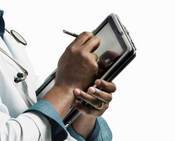HealthEssentials' Clinicians To Use Digital Pens
The Anoto Group and ExpeData digital pen and paper technology allows healthcare providers to document, store, and send patient data electronically.


Health IT Boosts Patient Care, Safety
(click image for larger view)
Slideshow: Health IT Boosts Patient Care, Safety
While the push is on for U.S. doctors to trade in their paper charts for electronic patient records, some healthcare providers are taking their paper and pens with them as they transition to a more digitized care processes.
HealthEssentials, which operates home health and hospice care organizations in California and Nevada, is rolling out digital pen and paper technology to its clinicians, including doctors and nurse practitioners, as well as health aides, social workers, and chaplains.
The digital pen and paper technology, from Anoto Group and ExpeData, is being used by HealthEssential clinicians and care providers in the field to replace the traditional pen and paper forms used to record patient information while caring for patients.
HealthEssentials is rolling out an electronic medical record system that will capture and contain the patient information created by workers using the digital pen and paper technology. Patient information will be stored as a PDF version of the paper form, but data will also be converted to text from fields on the paper forms.
During subsequent phases of the project, that text data will be collected into a centralized database, so that HealthEssential managers can run reports, track patient care trends, and glean other clinical insights, said Stacey Rodillon, project manager.
The paper forms used with the digital pens to collect data look similar to the traditional paper forms used by HealthEssential clinicians and field workers, said Rodillion. However, tiny dots printed on the forms help map information that’s recorded by the digital pens as users write.
The pens also write in ink as handwritten information is recorded on the paper forms and stored on a chip inside the pens. Data is submitted from a worker's digital pen to a HealthEssential central server via Bluetooth technology and the field worker’s BlackBerry, said Rodillon.

Top 10 Healthcare Stories Of 2010
(click image for larger view)
Slideshow: Top 10 Healthcare Stories Of 2010
HealthEssential's physicians group will also be using the technology to transmit prescriptions to pharmacies, electronically, said Rodillon. Approximately 20 physicians, nurse practitioners, and office staff have been using the digital pen and paper gear since June, and the technology is also being deployed to additional users -- including home health aides, other clinicians, social workers, and chaplains, she said. About 200 users will have the technology by end of summer, she said.
"Information from the forms is available immediately," to case coordinators, doctors, and others upon field workers transmitting the data from their digital pens and into the centralized e-medical records, said Rodillon. "This cuts down on time needed to make copies, and tracking down forms," she said.
Previously, copies of forms were faxed or submitted in person by field workers to their respective offices -- or information was phoned in, she said. Case coordinators also spent a large amount of their time filing the paper forms, she said.
HealthEssentials decided to deploy digital pen technology instead of rolling out an e-medical record that relies on typing in text in large part because the pens do not require field workers to dramatically change the way work, she said. “There’s a lot less training needed for this,” she said.
As for illegible handwriting -- Rodillon admits that can be an issue for some users, whether they’re writing with traditional pens or the digitized writing instruments. “In phase two, we’ll be cracking down on users” who continue their sloppy handwriting habits, she said.
The pens, software, and other related technology cost about $470 per user, and Rodillon estimates that HealthEssentials will reach a "break even" in its investments "within a few months." Based on the rollout so far, HealthEssentials estimates the technology will eliminate $23,000 in mileage costs; $101,000 in printing costs; $7,000 in form binder costs, and save $60,000 in staffing costs.
About the Author(s)
You May Also Like
How to Amplify DevOps with DevSecOps
May 22, 2024Generative AI: Use Cases and Risks in 2024
May 29, 2024Smart Service Management
June 4, 2024







